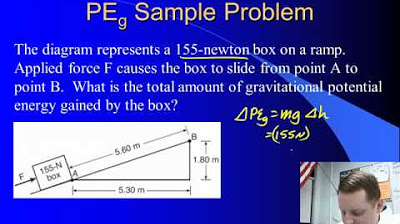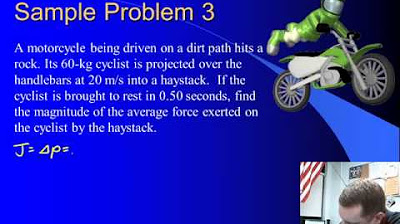AP Physics 1 - Work-Energy Theorem
TLDRThe video script discusses the work-energy theorem, explaining how work done on a system changes its energy. It covers various scenarios, including a chef pushing a cart, a pitcher throwing a baseball, and a force-displacement graph analysis. The examples illustrate how work affects kinetic and potential energies, and demonstrate calculations for final velocities and average forces. The content is engaging, providing a clear understanding of the theorem's practical applications.
Takeaways
- 📜 The work-energy theorem states that work done on a system changes its energy, affecting kinetic or potential energy based on the nature of the work.
- 🚀 Positive work by an external force increases a system's total energy, while work done by the system decreases its total energy.
- 🏃♂️ For work resulting in a change of motion, kinetic energy is impacted; for work changing an object's height, gravitational potential energy is affected.
- 🔄 Work done in compressing or stretching a spring affects the system's elastic potential energy.
- 🔧 Work against friction impacts the internal energy of a system.
- 👨🍳 Example problem: A chef pushes a 10 kg cart 5 meters with a 10 N force on a frictionless surface, resulting in a 3.2 m/s final velocity.
- 🥎 Second example: A pitcher throws a 143 g baseball at 45 m/s, and the catcher's hand stops it after 6 cm, exerting an average force of 2413 N.
- 📊 Final example: An object's final speed is determined from a force vs. displacement graph, with the work done equal to the area under the graph and related to the object's kinetic energy.
- 🌐 The work done is calculated as the sum of the areas of the geometric shapes in the force-displacement graph.
- 🎯 The final velocity of an object can be found using the work-energy theorem and the area under the force-displacement graph.
- 📚 For more information on the work-energy theorem, one can visit a physics education website.
- 🙂 The presentation concludes with a thank you and well-wishes, encouraging further exploration of the topic.
Q & A
What is the work-energy theorem?
-The work-energy theorem states that when a force does work on a system, the work done changes the energy of the system. Positive work done by an external force increases the system's total energy, while work done by the system decreases its total energy.
How does the type of energy affected by work depend on the nature of the work being done?
-The type of energy affected depends on the nature of the work. If the work results in a change of motion of an object, it impacts the kinetic energy. If the work changes the object's height, it affects gravitational potential energy. Compressing or stretching a spring affects elastic potential energy, and work against friction impacts the internal energy of the system.
In the example of the chef pushing a pasty cart, what are the given values?
-The given values are a mass of 10 kilograms for the cart, a displacement of 5 meters, and a constant horizontal force of 10 Newtons acting on the cart.
How much work is done by the chef on the pasty cart?
-The work done by the chef is 50 joules, calculated as the force (10 Newtons) times the displacement (5 meters).
What is the final velocity of the pasty cart?
-The final velocity of the pasty cart is 3.2 meters per second, calculated using the kinetic energy (50 joules) and the mass of the cart (10 kilograms).
What are the given values in the example of the pitcher throwing a baseball?
-The given values are a mass of 143 grams (0.143 kilograms) for the baseball, an initial velocity of 45 meters per second, and a displacement of the catcher's hand of 6 centimeters (0.06 meters).
What is the average force exerted on the catcher's hand when stopping the baseball?
-The average force exerted on the catcher's hand is 2413 Newtons, calculated using the work-energy theorem and the given values.
How can the work done be determined from a force versus displacement graph?
-The work done can be determined as the area under the force versus displacement graph, which is the sum of the areas of each section of the graph (triangles and rectangles).
What are the variables given in the final example involving a force versus displacement graph?
-The variables given are the maximum force (F max), the displacements (r1, r2, r3), the mass of the object (M), and the object's final speed (V).
How is the object's final speed calculated using the work-energy theorem and the force versus displacement graph?
-The object's final speed is calculated using the formula derived from the work-energy theorem, which relates the area under the force versus displacement graph (work done) to the change in kinetic energy of the object (1/2 MV^2).
What is the final speed of the object in terms of the given variables?
-The final speed of the object is given by the square root of (F max/m) times (-negative r1 + r2 + r3), derived from the work-energy theorem and the area under the force versus displacement graph.
Where can one find more information on the work-energy theorem?
-More information on the work-energy theorem can be found at a plus physics com.
Outlines
📚 Introduction to the Work-Energy Theorem
This paragraph introduces the work-energy theorem, a fundamental principle in physics that describes the relationship between work done by a force and the change in energy of a system. It explains how positive work done on a system increases its total energy, while work done by the system decreases its energy. The type of energy affected depends on the nature of the work, such as kinetic energy, gravitational potential energy, elastic potential energy, or internal energy. The paragraph also presents a problem involving a chef pushing a pasty cart, aiming to calculate the cart's change in kinetic energy and final velocity using the theorem.
🏐 Calculating Average Force in Ball Catch
The second paragraph discusses the application of the work-energy theorem to a scenario where a pitcher throws a baseball, and the catcher stops it. The goal is to determine the average force exerted on the catcher's hand. By using the theorem, the paragraph outlines the process of equating the change in kinetic energy to the work done, and then solving for the force using the known values of mass, initial velocity, and displacement. The example illustrates how the theorem can be used to analyze forces in sports and everyday situations.
📊 Interpreting Force-Displacement Graph for Final Speed
This paragraph focuses on using a force-displacement graph to find an object's final speed, given a net force applied horizontally and the object's initial rest state. The explanation involves calculating the area under the graph to determine the work done and then applying the work-energy theorem to find the change in kinetic energy. The paragraph provides a step-by-step approach to solving the problem, including the mathematical rearrangements needed to isolate the final speed variable. It concludes by presenting a formula that relates the object's final speed to the parameters of the force-displacement graph.
Mindmap
Keywords
💡Work-energy theorem
💡System
💡Kinetic energy
💡Gravitational potential energy
💡Elastic potential energy
💡Internal energy
💡Force
💡Displacement
💡Velocity
💡Friction
💡Net force
💡Area under the graph
Highlights
Work-energy theorem is discussed, which states that work done on a system changes its energy.
Positive work by an external force increases a system's total energy, while work done by the system decreases it.
The type of energy affected depends on the nature of the work, such as kinetic, gravitational potential, elastic potential, or internal energy.
Example problem: A chef pushes a 10 kg cart 5 meters with a 10 N force on a frictionless surface to find the change in kinetic energy and final velocity.
Work done is calculated as force times displacement, resulting in 50 Joules for the given example.
The final velocity of the cart is determined using the kinetic energy formula and is found to be 3.2 m/s.
Another example involves a pitcher throwing a 143 g baseball at 45 m/s, and the catcher's hand stops it after 6 cm displacement.
The average force exerted on the catcher's hand is calculated using the work-energy theorem and the displacement.
The force calculation results in an average force of 2413 N on the catcher's hand.
The final example is about a force vs. displacement graph to determine an object's final speed given various parameters.
The work done is equated to the area under the force-displacement graph, which is the sum of the areas of different sections.
The object's final speed is derived from the work-energy theorem and the calculated area, involving the formula for kinetic energy.
The final speed formula is simplified to express the speed in terms of the given parameters such as Fmax, r1, r2, r3, and M.
For more information on the work-energy theorem, a reference to aplusphysics.com is provided.
The transcript is a comprehensive guide to understanding and applying the work-energy theorem through various practical examples.
The examples demonstrate the theorem's application in calculating kinetic energy, average force, and final speed in different scenarios.
The work-energy theorem is a fundamental concept in physics with wide-ranging applications in problem-solving and understanding energy dynamics.
Transcripts
5.0 / 5 (0 votes)
Thanks for rating:





